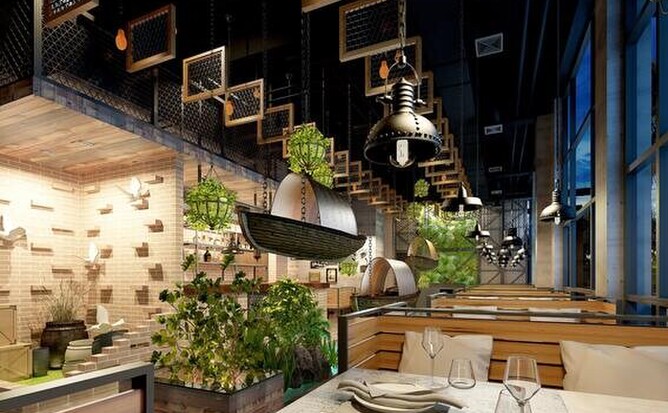Opening a restaurant in New York City presents both exciting opportunities and significant challenges. The city's vibrant culinary scene offers a diverse market, but competition is fierce. Restaurant building in NYC requires meticulous planning—not only regarding the menu but also zoning regulations, permits, and real estate costs. Success in this environment demands a strategic approach that combines creativity with practicality.
PE Builders recognizes the specific challenges NYC restaurateurs face. Through our commercial construction services, we help owners design and build restaurants that are functional and visually compelling. We make sure each space meets city regulations and customer expectations.
Choosing the Right Concept and Location
A restaurant’s concept is more than just its menu; it influences the customer experience, ambiance, and operational flow. Whether you aim to create a fast-casual eatery or a fine dining establishment, your concept needs to resonate with the target audience and match their dining expectations.
Key Elements of Your Concept
Customer experience: Define the type of experience you are offering—whether relaxed and family-friendly, fast-paced and efficient, or exclusive and luxurious. This includes every detail, from the seating arrangements to the level of service and the overall atmosphere. Your customer experience should be consistent with the expectations of your target demographic and complement the restaurant's concept.
Menu alignment: Make sure that your menu not only reflects your concept but also reinforces it through the types of dishes, their presentation, and pricing. For example, a casual concept might emphasize hearty, accessible meals, while a fine-dining restaurant focuses on sophisticated flavors and premium ingredients, presented with an artistic flair.
Location Considerations in NYC
Securing the right location is critical to your restaurant’s success. NYC's real estate market is not only competitive but also comes with high costs and specific zoning laws. Researching the demographics and competition in various neighborhoods will help identify which areas fit your concept.
For instance, a fast-casual concept might thrive in Williamsburg, while a fine-dining establishment may perform better on the Upper East Side. Factors like foot traffic, proximity to transportation, and nearby competition can greatly impact your success.
Crafting a Strong Business Plan
A comprehensive business plan is crucial not only for guiding your restaurant's development but also for securing funding. Investors and lenders require a detailed understanding of your concept, financial projections, and market position. Core elements of a business plan include the following.
Executive Summary
This section brings a concise overview of your restaurant concept, target audience, and business goals. It serves as the first impression for potential investors and must be engaging enough to capture their interest. A well-written executive summary outlines what makes your restaurant unique, along with key financial goals and growth potential, bringing a compelling snapshot of why your restaurant will succeed in the NYC market.
Market Analysis
In this section, you will conduct thorough research of the local market to understand your competitors and target demographic. Identify gaps in the current dining landscape and analyze how your restaurant will stand out. This analysis helps you demonstrate a clear understanding of the competitive environment and how your concept is tailored to meet market demand, guaranteeing your restaurant’s success in a competitive city like New York.
Financial Projections
Accurate financial projections are crucial for demonstrating the viability of your restaurant. This includes a detailed breakdown of startup costs, operational expenses, and anticipated revenue over time. Projections should also include a cash flow analysis, break-even point, and any contingency plans for unforeseen costs. Investors will scrutinize this section to gauge the financial health and sustainability of your business.
Marketing Strategy
A strong marketing strategy outlines how you plan to attract and retain customers, both in the lead-up to your opening and beyond. This includes digital marketing efforts such as social media campaigns, Google and Yelp reviews, and influencer partnerships, as well as offline strategies like hosting community events or collaborating with local businesses. Having a clear plan for both online and offline marketing makes sure of visibility in NYC’s crowded restaurant scene.
An accurate estimate of construction costs and timelines is also essential. Collaborating with experienced builders who offer pre-construction services make sure that your budget accounts for potential delays and unforeseen expenses. Having these projections integrated into your business plan can make it easier to secure financing and show investors that your project is well-thought-out.
Securing Funding for Your Restaurant
Securing funding for your NYC restaurant is often one of the most challenging aspects of the process. Most entrepreneurs require financial support to cover high real estate costs, equipment, permits, and staffing. There are many funding options available to choose from.
Bank Loans
Traditional loans are a common choice for restaurant financing because they typically deliver lower interest rates than other options. However, they come with stringent qualification requirements, such as a strong credit score, a solid business plan, and often collateral to secure the loan. In NYC, where real estate and startup costs are high, securing a bank loan can be challenging but is often the most cost-effective financing option if you qualify.
Private Investors
Seeking funding from private investors can provide the substantial capital needed to launch your restaurant, particularly in a high-cost market like NYC. However, this often comes with a trade-off, as investors typically expect equity in the business or a percentage of future profits. The terms of these investments should be negotiated carefully to guarantee long-term sustainability and a fair distribution of control.
Crowdfunding
Platforms like Kickstarter, GoFundMe, and Indiegogo allow you to raise funds directly from potential future customers. Crowdfunding often involves bringing rewards, such as free meals, exclusive experiences, or VIP invitations to events in exchange for contributions. This option not only helps raise capital but also builds a loyal customer base before you even open your doors.
In NYC, where costs are notoriously high, it is critical to plan for both expected and unexpected expenses. Partnering with experienced construction professionals helps minimize financial risks by delivering pre-construction services that provide realistic cost estimates and careful budgeting. This level of financial planning reduces the risk of budget overruns, making sure that your restaurant development stays on track and within budget.
Navigating Permits and Regulations
Opening a restaurant in NYC means navigating a labyrinth of permits and regulations. This process is necessary to guarantee that your restaurant is legally compliant and operates smoothly without interruptions.
Common permits needed:
Business License: This key permit allows you to legally operate in NYC and is required for all businesses. It confirms your compliance with city regulations and must be obtained before any other permits can be processed.
Foodservice License: To confirm your restaurant meets health and safety standards, you must secure a foodservice license. This requires passing a thorough inspection of your kitchen and food storage areas. The health department checks for proper sanitation, food handling, and equipment functionality to guarantee the safety of your patrons.
Liquor License: If your restaurant plans to serve alcohol, obtaining a liquor license is necessary. The application process often involves additional steps, such as background checks and approval from local authorities, which can take time, so it is important to begin this process early.
NYC’s health department enforces strict requirements for restaurant kitchens. Before being granted a foodservice license, your establishment will undergo a detailed health inspection to verify compliance with sanitation protocols, proper food storage, and the functional state of kitchen equipment. These inspections help your restaurant meet the city’s health and safety standards, preventing future operational delays or penalties.
Besides, NYC has intricate zoning laws that dictate what types of businesses can operate in different areas. Before signing a lease, have your chosen space zoned for restaurant use. Working with professionals who are familiar with NYC’s zoning and health regulations, can streamline the process and avoid costly mistakes.
Starting construction without all the necessary permits can result in fines, delays, or even having to halt the project. By securing all permits beforehand, you can confidently move forward with construction, knowing that you are compliant with NYC’s regulations.
Building and Designing Your Restaurant
The design of your restaurant not only affects the customer experience but also impacts the efficiency of your operations. A well-thought-out balance between the front-of-house (FOH) and back-of-house (BOH) spaces is necessary to bring smooth service.
Customer flow: The layout should prioritize smooth movement for both customers and staff so that there are no bottlenecks that hinder service. Entrances, exits, seating areas, and walkways must be planned to allow easy access to tables, restrooms, and the kitchen without disrupting the dining experience.
Seating: Striking the right balance between comfort and capacity is crucial. Your seating arrangement should reflect your restaurant’s concept. For a casual dining setup, you might want more tables in a cozy, informal style, while high-end dining requires more spacious, luxurious seating to enhance the customer experience. Comfort should never be sacrificed for additional capacity, as it can impact the overall ambiance and satisfaction.
BOH Design Considerations:
Kitchen Layout
The efficiency of your kitchen is heavily influenced by how the equipment is positioned. Ovens, refrigerators, and prep stations should be strategically placed to minimize unnecessary movement. This helps optimize the workflow, reduces preparation time, and helps that food delivered to the dining room promptly.
Storage and Sanitation
Adequate storage space is essential for keeping ingredients fresh and organized, while sanitation areas need to be easily accessible to maintain hygiene standards. Guaranteeing there are designated spaces for cleaning equipment and waste disposal is also important for meeting health regulations and keeping the kitchen running smoothly.
The materials you choose should not only complement your restaurant’s aesthetic but also meet NYC’s strict health and safety standards. Stainless steel is a common choice for kitchens due to its durability and ease of cleaning, while wood or brick might better suit the dining room for a rustic or warm ambiance.
Construction timeline
Timing is critical to your restaurant's success. Delays can be costly, especially if you have already hired staff or signed a lease. Working closely with designers, builders, and contractors makes sure that deadlines are met and keeps the project on schedule, minimizing the risk of opening delays that can affect your bottom line.
Hiring and Training Your Team
Building a skilled team is essential for your restaurant’s success. Your staff will define your restaurant’s culture and service quality, so it is important to recruit individuals who align with your vision.
Key roles to fill:
Management: General managers, kitchen managers, and FOH managers.
Kitchen Staff: Chefs, prep cooks, line cooks, and dishwashers.
FOH Staff: Servers, hosts, bartenders, and bussers.
Providing comprehensive training helps your team be well-prepared to handle the demands of opening a new restaurant. Training should focus on the restaurant’s layout, menu, and service standards to create a seamless experience for customers.
Advertising and Pre-Opening Events
Marketing your restaurant before it opens is essential for generating excitement and building a customer base. Establishing a robust online presence, especially on platforms like Instagram, Yelp, and Google, allows you to connect with potential customers.
Effective pre-opening Strategies:
Soft launch: Host a limited-seating event for friends, family, or local influencers to test your operations.
Exclusive events: Partner with local influencers or food bloggers to generate buzz around your opening.
Online listings and reviews are critical in NYC’s competitive dining scene. Encouraging early guests to leave positive reviews can help establish your restaurant as a must-visit spot in the city.
Opening a restaurant in NYC involves a mix of creativity, planning, and expert execution. From selecting the right concept and securing funding to building out the space and hiring the right team, each step plays a crucial role in your restaurant’s long-term success. At PE Builders, we bring the expertise and support needed to turn your restaurant vision into reality, guaranteeing a smooth and efficient process from start to finish.
By focusing on detailed planning and collaborating with experienced professionals, you can build a successful restaurant in one of the most competitive markets in the world.

